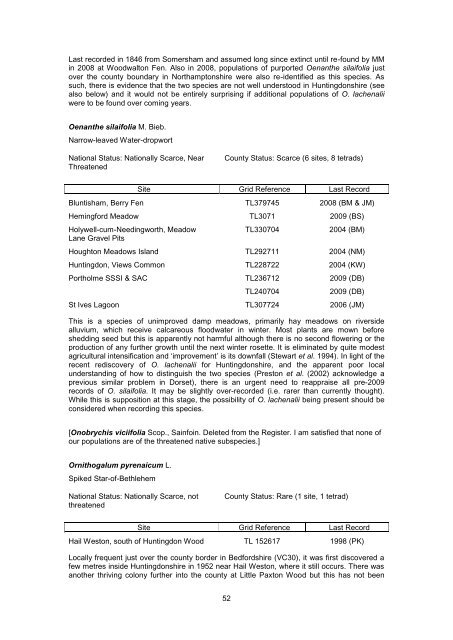Huntingdonshire - Botanical Society of the British Isles
Huntingdonshire - Botanical Society of the British Isles
Huntingdonshire - Botanical Society of the British Isles
You also want an ePaper? Increase the reach of your titles
YUMPU automatically turns print PDFs into web optimized ePapers that Google loves.
Last recorded in 1846 from Somersham and assumed long since extinct until re-found by MM<br />
in 2008 at Woodwalton Fen. Also in 2008, populations <strong>of</strong> purported Oenan<strong>the</strong> silaifolia just<br />
over <strong>the</strong> county boundary in Northamptonshire were also re-identified as this species. As<br />
such, <strong>the</strong>re is evidence that <strong>the</strong> two species are not well understood in <strong>Huntingdonshire</strong> (see<br />
also below) and it would not be entirely surprising if additional populations <strong>of</strong> O. lachenalii<br />
were to be found over coming years.<br />
Oenan<strong>the</strong> silaifolia M. Bieb.<br />
Narrow-leaved Water-dropwort<br />
National Status: Nationally Scarce, Near<br />
Threatened<br />
County Status: Scarce (6 sites, 8 tetrads)<br />
Site Grid Reference Last Record<br />
Bluntisham, Berry Fen TL379745 2008 (BM & JM)<br />
Hemingford Meadow TL3071 2009 (BS)<br />
Holywell-cum-Needingworth, Meadow<br />
Lane Gravel Pits<br />
TL330704<br />
2004 (BM)<br />
Houghton Meadows Island TL292711 2004 (NM)<br />
Huntingdon, Views Common TL228722 2004 (KW)<br />
Portholme SSSI & SAC<br />
TL236712<br />
TL240704<br />
2009 (DB)<br />
2009 (DB)<br />
St Ives Lagoon TL307724 2006 (JM)<br />
This is a species <strong>of</strong> unimproved damp meadows, primarily hay meadows on riverside<br />
alluvium, which receive calcareous floodwater in winter. Most plants are mown before<br />
shedding seed but this is apparently not harmful although <strong>the</strong>re is no second flowering or <strong>the</strong><br />
production <strong>of</strong> any fur<strong>the</strong>r growth until <strong>the</strong> next winter rosette. It is eliminated by quite modest<br />
agricultural intensification and ‘improvement’ is its downfall (Stewart et al. 1994). In light <strong>of</strong> <strong>the</strong><br />
recent rediscovery <strong>of</strong> O. lachenalii for <strong>Huntingdonshire</strong>, and <strong>the</strong> apparent poor local<br />
understanding <strong>of</strong> how to distinguish <strong>the</strong> two species (Preston et al. (2002) acknowledge a<br />
previous similar problem in Dorset), <strong>the</strong>re is an urgent need to reappraise all pre-2009<br />
records <strong>of</strong> O. silaifolia. It may be slightly over-recorded (i.e. rarer than currently thought).<br />
While this is supposition at this stage, <strong>the</strong> possibility <strong>of</strong> O. lachenalii being present should be<br />
considered when recording this species.<br />
[Onobrychis viciifolia Scop., Sainfoin. Deleted from <strong>the</strong> Register. I am satisfied that none <strong>of</strong><br />
our populations are <strong>of</strong> <strong>the</strong> threatened native subspecies.]<br />
Ornithogalum pyrenaicum L.<br />
Spiked Star-<strong>of</strong>-Bethlehem<br />
National Status: Nationally Scarce, not<br />
threatened<br />
County Status: Rare (1 site, 1 tetrad)<br />
Site Grid Reference Last Record<br />
Hail Weston, south <strong>of</strong> Huntingdon Wood TL 152617 1998 (PK)<br />
Locally frequent just over <strong>the</strong> county border in Bedfordshire (VC30), it was first discovered a<br />
few metres inside <strong>Huntingdonshire</strong> in 1952 near Hail Weston, where it still occurs. There was<br />
ano<strong>the</strong>r thriving colony fur<strong>the</strong>r into <strong>the</strong> county at Little Paxton Wood but this has not been<br />
52

















